Nugget Cache
ANNO LUCIS
Anno Lucis, or "Year of Light," is derived by subtracting 4,000 from Anno Domini. This method of dating assumes that the world was created 4,000 years before the birth of Christ. This explains the belief that Hiram Abiff was killed 3,000 years after the world's creation.
 Prior to scientific advancements, which revealed that the Earth's age should be measured in billions rather than thousands of years, estimates of Creation's date were rooted in biblical texts. In the seventeenth century, James Ussher, Archbishop of Armagh, developed a chronology based on the Old Testament, known as the ‘Annales Veteris’. He dated Christ's birth to 4,004 years after Creation.
Prior to scientific advancements, which revealed that the Earth's age should be measured in billions rather than thousands of years, estimates of Creation's date were rooted in biblical texts. In the seventeenth century, James Ussher, Archbishop of Armagh, developed a chronology based on the Old Testament, known as the ‘Annales Veteris’. He dated Christ's birth to 4,004 years after Creation.
This dating system gained popularity through its inclusion in the margins of the 1701 Bible edition and many subsequent editions. Similarly, the Hebrew calendar dates Creation to 3,760 BC.
When James Anderson crafted the First Constitution in 1723, he utilized this dating system, listing the year as both 1723 and 5723, referring to the latter as ‘In the year of Masonry’: Anno Latomiae (AL).
Over time, AL evolved into 'Anno Lucis', ‘In the year of Light.’ This tradition endures in Craft Masonry and features on every United Grand Lodge of England Certificate.
Neil Armstrong
February 2025
--ooOOoo--
Kingston’s Loving Cup
A cherished three-handled silver cup graces the top table at the Kingston’s Festive board, it was presented to the Lodge in 1945 as part of a legacy from W Bro James Willis-Mills, a retired solicitor who had become a joining-member in 1925.
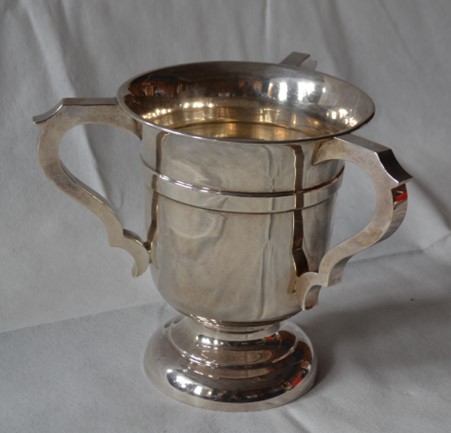 The sharing of the Loving Cup follows an incredibly old custom. Masonically the passing round of the cup occurred after the Entered Apprentice song had been sung to an Initiate and was similarly passed around at the Installation of a new Master.
The sharing of the Loving Cup follows an incredibly old custom. Masonically the passing round of the cup occurred after the Entered Apprentice song had been sung to an Initiate and was similarly passed around at the Installation of a new Master.
In the 18th century the masonic procedure was for three Brethren to stand, two would unsheathe their swords and the other one would hold up the cup by the two handles and drink whilst the two others defended his back.
Having quaffed, the drinker would wipe the cup with a napkin and pass it to his neighbour, drawing his sword and protecting his neighbour's back whilst he drank.
The custom of the protecting the drinker's back goes back to Anglo-Saxon times, when a man might be treacherously stabbed whilst drinking. Hence the need of a friend or two to defend him with drawn swords.
In AD 979 King Edward (later known as Edward the Martyr), was stabbed on the orders of his stepmother, Erida, so that her own son, Ethelred could become King instead.  He was stabbed by a paid assassin at a feast while drinking mead from a two handled loving cup .
He was stabbed by a paid assassin at a feast while drinking mead from a two handled loving cup .
Another variation of the Loving Cup is a large two-handled Scots quaich, a dish of pewter or silver. Some Scottish Lodges display their Masonic crest on the drinking vessel.
Why Kingston’s cup has three handles is not clear, but it is believed this made it easier for passing round the table. No more standing with drawn swords!
Today Health & Safety issues together with Covid have now consigned this custom to the history books.
Neil Armstrong
October 2023
--ooOOoo--
The Festive Board Snuffbox
A small almost insignificant snuffbox holds pride of place among the Kingston Lodge’s silverware. It sits on the table close to the WM at the Festive Board, though I have never seen it used for taking snuff.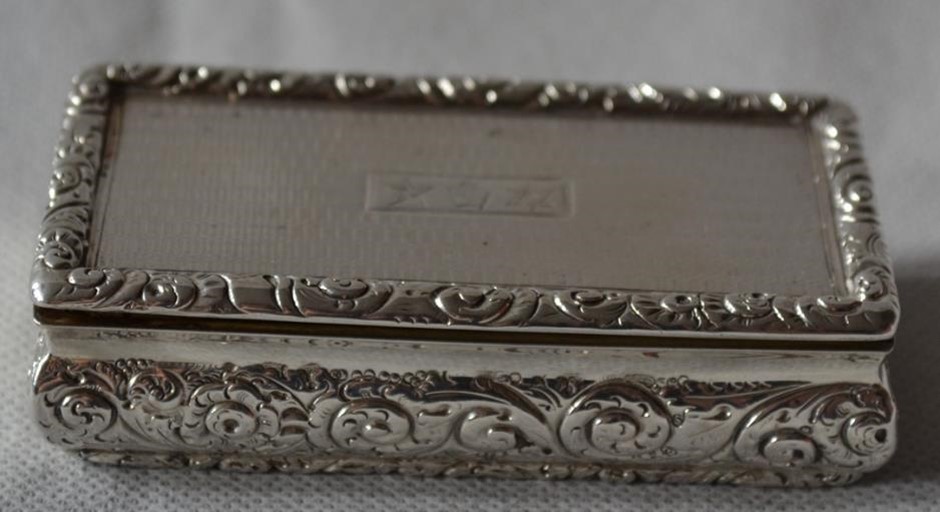
Closer examination shows it bears a dedicatory inscription; it was presented in memory of Captain T E B Sissons by W Bro H. W. Locking on 2nd April 1941, while the world was at war.
The box had originally belonged to Thomas Sissons, of the Hull paint manufacturer Sissons Bros & Co. He was Captain Sissons’ Great Grandfather, one of the Founders of the Kingston Lodge in 1864 and had passed the snuffbox on through the family.
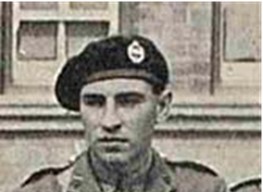 Great Grandson Thomas Edward Beswick Sissons joined Kingston Lodge in 1935 a year after his marriage. Twenty-five years old, he was also a member of the 1st Regiment East Riding Yeomanry (Territorials.)
Great Grandson Thomas Edward Beswick Sissons joined Kingston Lodge in 1935 a year after his marriage. Twenty-five years old, he was also a member of the 1st Regiment East Riding Yeomanry (Territorials.)
This regiment joined the British Expeditionary Force In 1940 to repel Hitler’s blitzkrieg invasions as part of the 1st Armoured Reconnaissance Brigade. They soon found they were fighting with utterly outmoded equipment against a modern army.
Near the town of Ath, south of Brussels, over the next fortnight they fought seven rearguard actions. Communication was sporadic and they finally became surrounded at Cassel on the night of 29th May 1940. The remnants of the Yeomanry column fought desperately while the Commanding Officer tried to keep a coherent and disciplined formation, but with smoke-bombs and ammunition exhausted, the order was given that it was every man for himself.
On the 30th May, Captain Sissons was killed in one of the many individual skirmishes that took place. By the end of that day the Regiment ceased to be a fighting force. Only seven officers escaped from Cassel and reached Dunkirk.
Tom Sissons’ sacrifice, like many others, secured the Allied Forces’ escape from the beaches of Dunkirk.
The Lodge is honoured to display the snuffbox. While at first glance it might appear small and insignificant, it bears silent witness to a Brother who is worthy of the term ‘Hero’.
Neil Armstrong
September 2023
--ooOOoo--
What is a Mason?
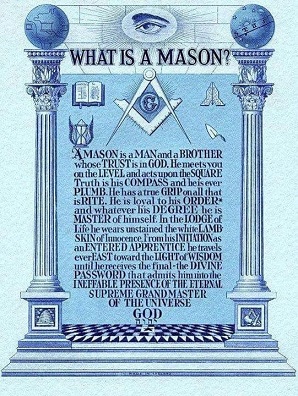
Sent by W Bro Marcus Whereat
August 2023
Where does our name come from?
The town of Wyke on Hull was founded in the late eleven-hundreds as a port, largely to export wool supplied by the monks of Meaux Abbey. (The River Hull flows into the Humber, which flows into the North Sea.)
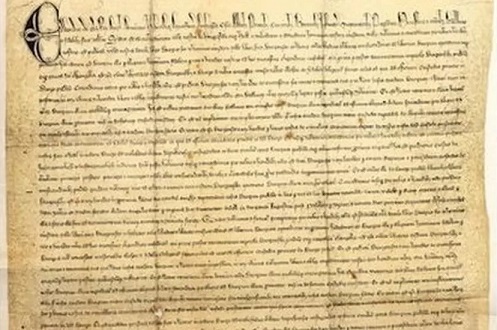 In 1296 King Edward I bought Wyke on Hull, and the neighbouring settlement of Myton from the monks. He wanted to use the port not only as a means of revenue through customs, but to transport supplies by sea to his troops fighting in Scotland. He issued the town with a Charter in 1299, written in Latin on parchment, re-naming it King's Town upon Hull, granting it borough status, with the right to hold its own court, market, and taxation system, under the jurisdiction of a Warden representing the monarch (known as the Mayor from 1331.)
In 1296 King Edward I bought Wyke on Hull, and the neighbouring settlement of Myton from the monks. He wanted to use the port not only as a means of revenue through customs, but to transport supplies by sea to his troops fighting in Scotland. He issued the town with a Charter in 1299, written in Latin on parchment, re-naming it King's Town upon Hull, granting it borough status, with the right to hold its own court, market, and taxation system, under the jurisdiction of a Warden representing the monarch (known as the Mayor from 1331.)
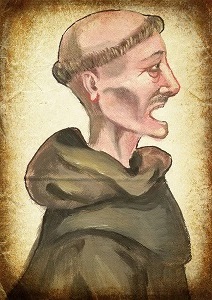 The royal decree changed the town of Wyke on Hull to what we now know as Kingston upon Hull.
The royal decree changed the town of Wyke on Hull to what we now know as Kingston upon Hull.
Thus it is because of where we live that Kingston Lodge 1010 is so named. Thirty-three years after the consecration of the Lodge, Hull was granted full city status (1897.)
Other kings and queens have given charters to Hull over the years, granting new privileges and confirming existing ones.
Hull had a very different episode involving a sovereign in 1642, but that's another story.
Eddie Wildman
August 2023
Installation, Appointment and Investiture
There is often confusion between the words Installation, Appointment and Investiture, perhaps because they are frequently used in close proximity at installation ceremonies."Installation" means "put in place" (as in the installation of a new central heating system.) "Appointment" means "Assigning someone to an office or position" and "Investiture" in a Masonic sense means "rewarding with office".
Thus at an Installation Ceremony the WM is installed into the Chair (i.e. sat in place in the east) and he appoints and invests his officers (i.e. announces what jobs his team are going to do, and gives them collars (invests them) so that others can see what their office is.
 "Install" derives from Latin meaning "in place" and was used ecclesiastically when a monk or cleric taking office was placed in his "stall" or seat. The WM is placed in his stall, as it were.
"Install" derives from Latin meaning "in place" and was used ecclesiastically when a monk or cleric taking office was placed in his "stall" or seat. The WM is placed in his stall, as it were.
"Appoint" comes from Old French (meaning point or position) - Officers have particular places in the Lodge, such as the SW in the west.
"Invest" has its roots in the Latin word for clothing (remember that a vest is an undershirt) and Masonically when someone is invested, he will wear a collar carrying a visible sign of the Office he represents. The "jewel" at the bottom of the collar is the symbol of the Office, So the Senior Warden carries the emblem of the level as a symbol of equality.
UGLE's Update of the Words
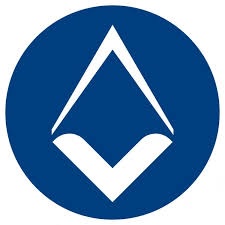 If you ask a Freemason what the order is founded upon, he will tell you “Brotherly Love, Relief and Truth” because that’s part of which we commit to memory.
If you ask a Freemason what the order is founded upon, he will tell you “Brotherly Love, Relief and Truth” because that’s part of which we commit to memory.
But to anyone who’s not a Mason, it doesn’t explain very much. So the Big Boys in London – the UGLE – are encouraging us to update the wording when talking to people who are not yet Brethren.
Masonry is about building, of course, and Grand Lodge notes that there are four sorts of building we do, under the headings Integrity, Friendship, Charity and Respect.
Integrity is about building good people.
Friendship is about building together.
Respect is about building unity, bringing people together regardless of race, religion or culture,
And Charity is about building compassion.
That’s what we’re about.
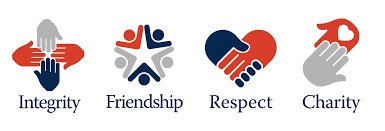
Eddie Wildman
Squaring the Lodge
Originally sent in an email by Ian Syddall during the covid pandemic]
Question:
Why do we square the lodge?
Answer:
 Not all lodges do so, however many do and it is almost certain that the practice arose unintentionally. In the early 1730s, the 'lodge', i.e. the Tracing Board, was drawn on the floor, usually within a border, or else the 'floor-cloth' (then just coming into use) was rolled out in the middle of the floor. In the small tavern rooms, which were the principal places of meeting, there cannot have been much space left for traversing the lodge and if the 'drawing' or 'floor-cloth' was to be protected, a certain amount of squaring was inevitable.
Not all lodges do so, however many do and it is almost certain that the practice arose unintentionally. In the early 1730s, the 'lodge', i.e. the Tracing Board, was drawn on the floor, usually within a border, or else the 'floor-cloth' (then just coming into use) was rolled out in the middle of the floor. In the small tavern rooms, which were the principal places of meeting, there cannot have been much space left for traversing the lodge and if the 'drawing' or 'floor-cloth' was to be protected, a certain amount of squaring was inevitable.
Of course, it was not the 'heel-clicking' type of precise squaring, but simply a natural caution to avoid disturbing or spoiling the design. There is a minute, dated 1734, of the Old King's Arms Lodge, now No. 28, which mentions 'the Foot Cloth made use of at the Initiation of new members', but the earliest pictures of 'floor-cloths' in use, are dated 1744, and they show fairly large designs laid out to cover most of the floor of a small lodge room, with all the Brethren grouped around.
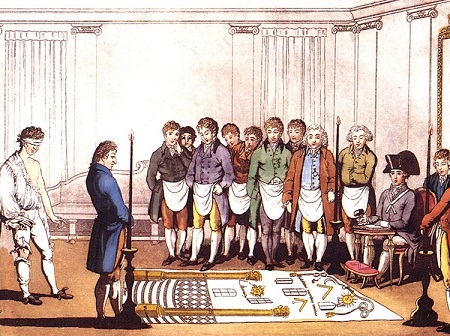 Looking at some engravings, one can see that squaring was almost obligatory.
Looking at some engravings, one can see that squaring was almost obligatory.
An early record describing perambulations round the ‘floor cloth' is in "Reception d'un Frey Macon", 1737, which says that the Candidate was ... made to take three tours in the Chamber, around a space marked on the Floor, where ... at the two sides of this space they have also drawn in crayon a great J. and a great B. ...
Most workings nowadays square the Lodge, clockwise, during the ceremonies, but the exaggerated squaring, which requires all movements to be made clockwise round the floor of the Lodge and forbids crossing, probably took its rise in the early 1800's.
Ian Syddall
~o~
Past Master's Jewel
[submitted by Eddie Wildman December 2019]
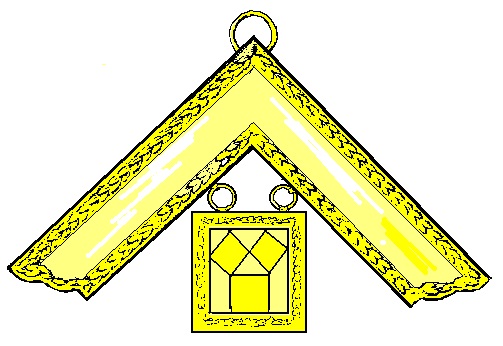 The Past Master's Jewel indicates that the recepient has not only served the Lodge for a year but is now figuratively able to build complex constructions using the 47th proposition of Euclid.
The Past Master's Jewel indicates that the recepient has not only served the Lodge for a year but is now figuratively able to build complex constructions using the 47th proposition of Euclid.
(This is the Pythagorean theorum that in a right-angled triangle, the square of the hypotenuese is equal to the sum of the square of the other two sides.)
~o~
Prudence, Temperance, Fortitude & Justice
[submitted by David Terry of the Humber Lodge January 2020]

The above are the four Cardinal Virtues we hear of in the 1st Degree Charge and are represented by the four tassels at each corner of our Lodge carpet.
Prudence
is the ability to discern the appropriate course of action to be taken in a given situation at a given time.
It also means “discreet and worldly wise”.
Fortitude
– Courage, Strength and Endurance.
Temperance
– Self control Discretion and Moderation.
Justice
- Sense of Fairness
Coupled with Benevolence and Charity, the above virtues are the essential signposts to a happy, meaningful and balanced life.
David Terry
~o~
Best Wishes
[Submitted by Eddie Wildman March 2020]
 Children like to tell who's best at things: the fastest runner, the chess wizard, the academic genius; teenagers often impress by knowing who's top in the charts, or who has the most Facebook hits; even as adults we observe who's wealthiest, oldest, fittest or luckiest.
Children like to tell who's best at things: the fastest runner, the chess wizard, the academic genius; teenagers often impress by knowing who's top in the charts, or who has the most Facebook hits; even as adults we observe who's wealthiest, oldest, fittest or luckiest.
In the Lodge however, under the All-Seeing -Eye of The Great Architect of the Universe, we know that whatever the colour of the aprons we wear, we are all Brethren together, and as such, all equal.
~o~
Knock, knock - who's there?
[Submitted by Phil Watts March 2020]
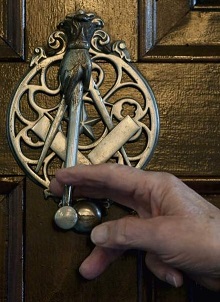 What is the difference between an “Alarm" and a "Report"? A report is a correct knock in the appropriate circumstances and an alarm is an incorrect knock, serving as some sort of warning. To clarify: A report must match the degree in which the lodge is open. In the case of an initiation the Tyler gives only one knock, and one knock having no Masonic status suggests that he who seeks admission has no Masonic status, indeed he is a Mister entering an open Masonic lodge. When a candidate is to be passed the Tyler gives the “Alarm" or First degree knocks as the candidate is NOT qualified to enter. Likewise when a candidate is to be raised the Tyler gives the “Alarm" of Second degree knocks. It would be well if the Inner Guard was aware of the distinction when reporting to the Junior Warden. He in turn making the announcement to the Master, should use the same term that the Inner Guard uses.
What is the difference between an “Alarm" and a "Report"? A report is a correct knock in the appropriate circumstances and an alarm is an incorrect knock, serving as some sort of warning. To clarify: A report must match the degree in which the lodge is open. In the case of an initiation the Tyler gives only one knock, and one knock having no Masonic status suggests that he who seeks admission has no Masonic status, indeed he is a Mister entering an open Masonic lodge. When a candidate is to be passed the Tyler gives the “Alarm" or First degree knocks as the candidate is NOT qualified to enter. Likewise when a candidate is to be raised the Tyler gives the “Alarm" of Second degree knocks. It would be well if the Inner Guard was aware of the distinction when reporting to the Junior Warden. He in turn making the announcement to the Master, should use the same term that the Inner Guard uses.
~o~
~o~
How Many Right Angles?
[Submitted by Eddie Wildman 1st October 2020]
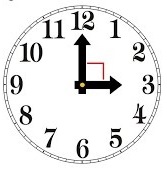 The angle of the square is significant to Freemasons: we act "on the square" - by it we regulate our lives and actions. Many Lodges after their Festive Board drink a toast to Absent Brethren when the clock hands are at right angles (usually at 9.00 pm or just after 9.30 pm.)
The angle of the square is significant to Freemasons: we act "on the square" - by it we regulate our lives and actions. Many Lodges after their Festive Board drink a toast to Absent Brethren when the clock hands are at right angles (usually at 9.00 pm or just after 9.30 pm.)
How many times are the minute and hour hands of the clock at right angles in the course of the day? The answer may surprise you: watch the short video to find the answer! https://www.youtube.com/watch?v=-HGUYW2-VlA
~o~
. . . And so to Refreshment
W Bro David Terry delivered this as a Zoom lecture during Covid.
 Brethren, this talk entitled ‘…and so to refreshment’ is about the origins of the customs observed at our Festive boards. In this context a board is a table laden with food as in the phrase ‘bed and board’. The first recorded Masonic festive boards were held by operative masons in the 14th century; usually to celebrate religious festivals, but may also have been arranged for the purely Masonic gatherings referred to in the Old Charges.
Brethren, this talk entitled ‘…and so to refreshment’ is about the origins of the customs observed at our Festive boards. In this context a board is a table laden with food as in the phrase ‘bed and board’. The first recorded Masonic festive boards were held by operative masons in the 14th century; usually to celebrate religious festivals, but may also have been arranged for the purely Masonic gatherings referred to in the Old Charges.
On these special days they would gather in the buildings under construction or in temporary shelters called Lodges to feast on roast meat washed down with spiced ale. The 14th century Regis manuscript laid down how masons should behave at these Festive Boards; they should come to the table with clean hands, not speak with their mouths full and refrain from using the napkins to blow their noses. All still good advice!
In the late 17th and early 18th centuries the early Speculative Masons held their meetings in taverns, inns, or sometimes coffee houses; so refreshments were readily available to them. Many lodges were later named after these first meeting places; such as the Globe Lodge No23 which met at The Globe Tavern. Indeed, the first Grand Lodge met in an alehouse called the Goose and Gridiron near St Paul’s Cathedral; possibly attracted there by the much acclaimed charms of Hannah the barmaid. The smallness of the rooms in many of these establishments did restrict lodge membership, so later in the 18th century hotels became increasingly popular meeting places as they could provide bigger rooms as well as better facilities.
The early Speculative Masons met more often than we do today and for them the Festive Board was not a separate event to the Masonic meeting itself; some lodges even initiated ‘serving brothers’ solely to be waiters or musicians at their meetings. During meetings the brethren ate snacks, drank and smoked; so their aprons were soon stained or damaged and lodge accounts record their regular replacement. They also sang songs and drank toasts, often accompanied by very noisy Masonic Fire and the stamping of feet. The 1760 exposure ‘Three Distinct Knocks’ records that people sitting below meeting rooms were sometimes frightened that the building would be shaken down by them.
The Junior Warden calling the Brethren to or from labour and refreshment had a vital role in managing these proceedings. Then as now the discussion of politics and religion was not allowed during either period, creating a spirit of tolerance that set Freemasonry apart from most other fraternities. Once the Masonic business was completed the Lodge would be formally closed, but the brethren often stayed on to take supper and continue making merry.
The degree rituals they worked were much shorter than ours today. Instead, for much of the meeting the brethren would sit round a candlelit table listening to lectures and taking part in the catechisms, question and answer rituals to test their Masonic knowledge. The lectures were not just Masonic but included other learned topics such as architecture, even medical dissections are recorded; the Old Kings Arms Lodge held a series of such lectures in the 1730s. One given by a Brother Graeme about the fermentation of intoxicating liquors probably had samples to taste, as the minutes record that the brethren were ‘greatly delighted’ and asked Bro. Graeme to speak again on the same subject on no less than three occasions!
Heavy drinking was commonplace in those days and lodge accounts record the purchase of ale, wine and spirits, as well as sugar and lemons to make punch. Although at initiations some lodges would make the candidate pay for all the food and drink Some Masons said that the bonds of friendship would only tighten when ‘wet’ and a popular Masonic song of 1778 ran:
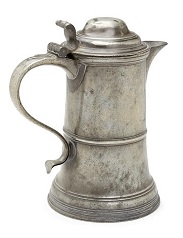 ‘Let every man take a glass in hand,
‘Let every man take a glass in hand,
Drain bumpers to our Master Grand,
As long as he can sit or stand.’
Masons were probably one of the better-behaved elements of society, as they did have strict rules to govern behaviour and limit drinking at their meetings. Today the Ancient Charges & Regulations read to a Master Elect still require him to guard against intemperance and excess in his Lodge.
Typical of the early lodge rules were the 1760 Bylaws of the Lodge of Antiquity which stipulated that any brother who discussed religion or politics, bet, cursed, was ‘disguised in liquor’ or hissed at a speaker would be fined. In 1786 a Brother in the Mount Maria Lodge No. 34 was fined 6 pence for falling asleep in the lodge. Even visitors could be fined. In 1783 the Albion Lodge No. 9 fined a visitor a shilling for swearing, whereupon he challenged the Master to a duel; the Lodge was then closed, so the outcome was not recorded.
Such bylaws and fines were not always sufficient to control excess. The Mariners’ Lodge No. 576 founded in 1799, had a side table laden with wine and spirits in their meeting room and for 6 pence members could take drinks as they wished. It was a very merry Lodge so soon ran into financial difficulties and in 1822 it was erased with some members’ refreshment bills well in arrears. They left us a fascinating record of their history, plus an unusual Masonic jug that apart from various Craft symbols also bears an advertisement for the good ale available at the ’Rose and Crown’.
 Most 18th century lodges arranged formal dinners to celebrate their installation meetings. In 1753 at the annual feast of the Old Dundee Lodge No.18 it is recorded that 33 brethren dined on 2 quarters of lamb with beef gravy, 12 fowls, a 23lb ham and 2 plum puddings, all washes down by an assortment of alcoholic beverages.
Most 18th century lodges arranged formal dinners to celebrate their installation meetings. In 1753 at the annual feast of the Old Dundee Lodge No.18 it is recorded that 33 brethren dined on 2 quarters of lamb with beef gravy, 12 fowls, a 23lb ham and 2 plum puddings, all washes down by an assortment of alcoholic beverages.
After these dinners female relations and lady friends were sometimes invited into the lodge room or an adjoining gallery. Later in the 19th Century special Ladies Dinners and Masonic Balls became popular; our present-day Ladies Festivals developed from such events. In the early days less respectable ladies may sometimes have been invited into meetings. In 1757 Bro. Storey of the Grenadiers Lodge No. 66 was fined 2 pence for bringing a woman into the lodge during lodge hours; their Junior Warden was also fined 2 pence, but in his case for kissing her.
After the unification of the two Grand Lodges in 1813 Masonic meetings started to change significantly. The rituals grew longer so the meetings became much more formal and there was less opportunity for conviviality in the meeting room itself. The communal tables in Lodge rooms started to be replaced by pedestals and eventually food, drink and smoking were banned from lodge rooms; although in some provincial lodges the old customs were slow to disappear.
To accommodate a growing number of lodges and the increased number of brethren many new dedicated Masonic Halls opened during the late Victorian and Edwardian period. Although taverns and hotels might still be used for dining, as formal festive boards after every meeting was becoming the custom. Sometimes Masonic regalia was still worn at these separate festive boards, but the practice soon died out, although a few Lodges such as the Mount Moriah Lodge No. 34 still dine in full regalia and in others, all or some of the officers wear their collars at the Festive Board. Dining customs such as the clapping in of the Master and loving cups also started to appear around this time; often being copied from the Craft Guilds and Livery Companies.
Although increasingly formal 19th century festive boards could still be lively events. In 1806 the Premier Grand Lodge asked their stewards to ensure that the dining fees would cover the cost of broken glasses and a carpenter for repairs to the furniture. Then in 1815 to control over exuberance Grand Lodge banned soda water and nuts from their festive boards; what brethren had been doing with them is not recorded!
 Music and singing at the Festive Board has always been popular. In 1737 several Lodges contributed towards the costs of three separate bands to play in the procession to that Year’s Grand Festival Feast. Many Masonic songbooks were published and songs were included in the first Book of Constitutions; the only one of these early songs still regularly sung today is the Entered Apprentices Song. First published in the early 1700s, the lyrics were probably written by Matthew Birkhead, an actor comedian at the Drury Lane Theatre.
Music and singing at the Festive Board has always been popular. In 1737 several Lodges contributed towards the costs of three separate bands to play in the procession to that Year’s Grand Festival Feast. Many Masonic songbooks were published and songs were included in the first Book of Constitutions; the only one of these early songs still regularly sung today is the Entered Apprentices Song. First published in the early 1700s, the lyrics were probably written by Matthew Birkhead, an actor comedian at the Drury Lane Theatre.
These songs often had wine taking and toasts built in between the verses but the first formal reference to Masonic toasts is in Anderson’s 1738 Book of Constitutions. This refers to the Grand Master reviving in 1719 the old and peculiar toasts of the Freemasons but does not elaborate on the form they took. However, we know from the early exposures that Masonic Fire was taken with these toasts.
The custom of Firing is not exclusively Masonic and is believed to derive from an old tradition at military or public events of firing cannons or muskets to mark a toast; Shakespeare referred to this practice in Hamlet. We do know of Masonic instances of such real Firing. In 1741 the Vernon Lodge in Dublin held an open air celebration where each toast was marked by musket fire and at a Masonic Annual Feast held near Sunderland in 1775 it was reported that the toasts were ‘drunk with the discharge of a cannon’, hopefully not a full size one! The use of actual cannons and muskets was exceptional, but it did become the practice for diners to mark a toast by banging their glasses down in imitation of their fire. Although some writers suggest that the enthusiastic banging down of glasses came first and the similarity to musket or cannon fire was noted subsequently.
The earliest written accounts of Masonic Fire are French, but this does not necessarily mean it originated in France. The first detailed description was given in the 1737 French exposure ‘Reception d’un Frey-Macon’, which used information obtained by Mademoiselle Carton of the French Opera in return for her favours. It called the wine powder and the glasses firearms, and said that to drink an Initiates health the brethren rose and the Master would tell them to ‘charge’ their glasses. Then on the command ‘lay your hands on your weapons’ the glass was lifted to the lips in three movements and they drank. The empty glass was then moved to the left breast, the right breast and held out to the front three times; before, again in three movements it was set down hard on the table. After which the brethren clapped their hands and shouted ‘VIVAT’ three times. Cheers in English.
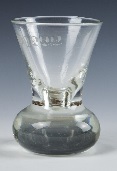 Later exposures expanded the gunfire analogy, calling the bottles ‘barrels’ and the goblets ‘cannon’. The instruction for a toast being Charge Cannons- Present Arms-Take Aim- Fire- Grand Fire!’. Our present day Wardens reporting their columns ‘All charged in the South and West’ recalls this old instruction.
Later exposures expanded the gunfire analogy, calling the bottles ‘barrels’ and the goblets ‘cannon’. The instruction for a toast being Charge Cannons- Present Arms-Take Aim- Fire- Grand Fire!’. Our present day Wardens reporting their columns ‘All charged in the South and West’ recalls this old instruction.
In England the 1734 minutes of The Old King’s Arms Lodge No.28 record the health of the Master Elect being drunk with ‘three times three’, but the first detailed English descriptions of Masonic Fire do not appear until the exposures of the 1760s. These say that the Deacons first ensured that the glasses were all fully charged, the Master would then lift his glass and propose a toast with three times three in the apprentice way, the brethren repeated the toast and drank. Then copying the Master they held their empty glasses to the fore before drawing them three times across the throat and setting them back down on the table in three motions, ‘Firing’ on the last with a loud report. After which the Brethren raised their hands breast high and clapped nine times in three groups of three, stamping their feet in unison and finishing with a final ‘HUZZA’ before sitting down.
Glasses often shattered during such firing and Brethren were fined when this happened; in 1767 the Old Lodge at Wakefield fined two brothers a shilling each for glasses ‘burst in a Fire’. Special firing glasses were made with strengthened bottoms to reduce breakages, but over time most lodges gave up signing with glasses; moving instead to the type of Fire we know today, which we can now consider in more detail.
Various origins have been suggested for the 3 point –left-right gestures that commence the Fire, that they might represent the sign of the Cross or even a trowel spreading cement. However the evidence clearly indicates that they are the vestiges of the Apprentice signs alluded to in the first descriptions of Firing, which also explains why the Festive Board is tyled in some Lodges. These signs have now degenerated to just token pointing gestures, although the Emulation Lodge of Improvement do still use the recognised Entered Apprentices sign in the Fire given during their1st Degree lecture. The early exposures do in fact record different toasting rituals for each degree, each one having similarities to the different degree signs and salutations that we use today; a few Lodges, such as the Lodge of Peace No.149 in Yorkshire and the Lodge of Loyalty No. 358 in Bermuda, still give a fire similar to the Fellowcraft’s salutation.
Next in the Firing sequence is a ‘1-2’ count. This is reminiscent of the two motions previously made prior to banging the glass down but it now heralds an extra clap added to the original nine, or sometimes the Master gavelling. Our fire is usually completed by nine claps given in three groups of three. Audible salutes given by clapping, stamping the feet or striking the apron are frequently mentioned in the early records. The number in this instance may derive from the Entered Apprentice knocks, or be in token of the nine signs for a true Freemason referred to in some early Masonic exposures.
There is no evidence to suggest that our Firing is in any way connected to the 21-gun naval salute. The actions in the most commonly used Fire do total 21 but each element is clearly of a separate origin.
 Masonic Fire is not universal in Freemasonry and varies widely in form and speed. Some Lodges still use Firing glasses and others use small gavels to give Fire. A few give Running Fire, where each Brother bangs his glass down in turn; or a variation called Roll Fire where the glass is also ground on the table in a circular motion. In another variation the Lodge of Regularity No. 91 give Secretary Fire, where the brethren whisper messages around the table before banging their Firing Glasses down. The Fitzroy Lodge No. 569 gives Regimental Fire, where the actions are said to represent the swinging of a fuse or taper to keep it glowing before a grenade is symbolically lit and thrown.
Masonic Fire is not universal in Freemasonry and varies widely in form and speed. Some Lodges still use Firing glasses and others use small gavels to give Fire. A few give Running Fire, where each Brother bangs his glass down in turn; or a variation called Roll Fire where the glass is also ground on the table in a circular motion. In another variation the Lodge of Regularity No. 91 give Secretary Fire, where the brethren whisper messages around the table before banging their Firing Glasses down. The Fitzroy Lodge No. 569 gives Regimental Fire, where the actions are said to represent the swinging of a fuse or taper to keep it glowing before a grenade is symbolically lit and thrown.
The Silent Fire sometimes used for the Absent Brethren and Tylers’ Toasts may derive from the Quiet Fire once used to honour departed brethren; although the Tylers’ Fire may be silent, as when directing it he cannot be outside the door to prevent eavesdroppers.
Let’s leave Masonic Fire there and return to the development of the festive board as a whole. As the 19th Century closed they reached their zenith as elaborate dining events. Having become formal dinner-suited affairs, with up to ten course meals, many wine takings and long toast lists; all accompanied by music and singing, often from professional entertainers. These customs and practices continued into the early 20th Century and many can still be found at our festive boards today; but social change and modern tastes, coupled with rising costs, have progressively led to less formality, shorter menus and fewer toasts.
However 20th Century festive boards could still be extraordinary events. In 1925 possibly the largest ever Masonic festive board was held at London Olympia to raise funds for the new Freemasons Hall in London; over 7000 brethren sat at over 3 miles of tables and were served by 1360 waitresses. More bizarrely, in 1946 a Masonic journal advertised the sawing of a woman in half as a festive board entertainment; hopefully this was the time-honoured conjurors’ illusion rather than enactment of one of our traditional penalties!
Finally if in the festive board tradition I could close with a toast it would be to our Masonic forebears who left us such a rich legacy of good fellowship, good manners and good Fire. Brethren, thank you.
This talk was taken from a booklet “A Medley of Masonic Talks” by Brother Clive R Moore of Kent, England. It was then adapted by V W Bro Robert Taylor.
~o~
The Old Black Shoes
The following poem has been sent to me from a number of Masonic sources. As a comment on Masonry and the effects of the coronovirus pandemic crisis it deserves recording here. I believe it to be by W Bro Mark Davis of the Old Sunning Lodge 5987 in Berkshire.
The old black shoes are looking glum, as I passed the lobby door,
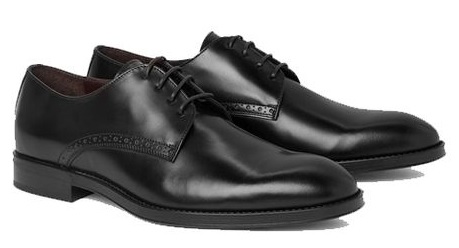 "What’s wrong with you?" they seem to say, "we’re going out no more.
"What’s wrong with you?" they seem to say, "we’re going out no more.
We’ve taken not a single step, not a third or even first,
And ne’er a sign we’ve seen you give, has Masonry been cursed?"
"It has," I said, "by virus vile: we have to stay at home,
Until such time the plague has passed, then once more we can roam.
The Masons' halls are empty, regalia put away,
Gavels now stay silent, DCs hold no sway,
Volumes of the Sacred Law, on pedestals redundant,
Now Brother Jim contacts his friends, by social posts abundant.
No handshake, word or secret sign, no friendly festive board,
No Tyler’s song to say good night, no organ's well-loved chord.
Black shoes," I said, "do not despair, our chain is firm and strong,
Our flag of love remains unfurled, we’ll sing again our song.
And though our brethren may have passed to the Grander Lodge above,
We’ll look upon their memories with everlasting love,
And in their name we’ll offer help and soothe the burdened heart,
We’ll comfort those who are distressed, thus Masons play their part.
And when this crisis is resolved, will sing the old refrain,
'Happy to meet, sorry to part, happy to meet again.'"
~o~
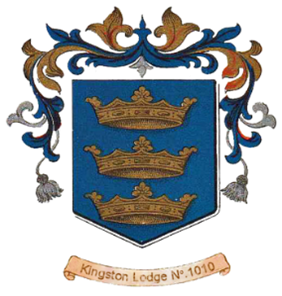
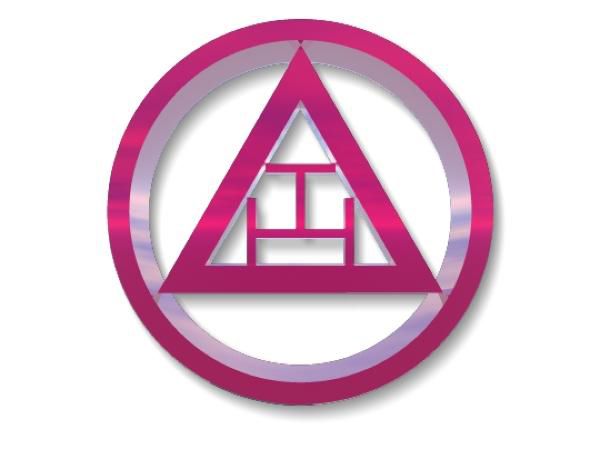

 The sharing of the Loving Cup follows an incredibly old custom. Masonically the passing round of the cup occurred after the Entered Apprentice song had been sung to an Initiate and was similarly passed around at the Installation of a new Master.
The sharing of the Loving Cup follows an incredibly old custom. Masonically the passing round of the cup occurred after the Entered Apprentice song had been sung to an Initiate and was similarly passed around at the Installation of a new Master. He was stabbed
He was stabbed 
 Great Grandson Thomas Edward Beswick Sissons joined Kingston Lodge in 1935 a year after his marriage. Twenty-five years old, he was also a member of the 1st Regiment East Riding Yeomanry (Territorials.)
Great Grandson Thomas Edward Beswick Sissons joined Kingston Lodge in 1935 a year after his marriage. Twenty-five years old, he was also a member of the 1st Regiment East Riding Yeomanry (Territorials.)
 In 1296 King Edward I bought Wyke on Hull, and the neighbouring settlement of Myton from the monks. He wanted to use the port not only as a means of revenue through customs, but to transport supplies by sea to his troops fighting in Scotland. He issued the town with a Charter in 1299, written in Latin on parchment, re-naming it King's Town upon Hull, granting it borough status, with the right to hold its own court, market, and taxation system, under the jurisdiction of a Warden representing the monarch (known as the Mayor from 1331.)
In 1296 King Edward I bought Wyke on Hull, and the neighbouring settlement of Myton from the monks. He wanted to use the port not only as a means of revenue through customs, but to transport supplies by sea to his troops fighting in Scotland. He issued the town with a Charter in 1299, written in Latin on parchment, re-naming it King's Town upon Hull, granting it borough status, with the right to hold its own court, market, and taxation system, under the jurisdiction of a Warden representing the monarch (known as the Mayor from 1331.)  The royal decree changed the town of Wyke on Hull to what we now know as Kingston upon Hull.
The royal decree changed the town of Wyke on Hull to what we now know as Kingston upon Hull. "Install" derives from Latin meaning "in place" and was used ecclesiastically when a monk or cleric taking office was placed in his "stall" or seat. The WM is placed in his stall, as it were.
"Install" derives from Latin meaning "in place" and was used ecclesiastically when a monk or cleric taking office was placed in his "stall" or seat. The WM is placed in his stall, as it were. If you ask a Freemason what the order is founded upon, he will tell you “Brotherly Love, Relief and Truth” because that’s part of which we commit to memory.
If you ask a Freemason what the order is founded upon, he will tell you “Brotherly Love, Relief and Truth” because that’s part of which we commit to memory.
 Looking at some engravings, one can see that squaring was almost obligatory.
Looking at some engravings, one can see that squaring was almost obligatory. The Past Master's Jewel indicates that the recepient has not only served the Lodge for a year but is now figuratively able to build complex constructions using the
The Past Master's Jewel indicates that the recepient has not only served the Lodge for a year but is now figuratively able to build complex constructions using the 
 Children like to tell who's best at things: the fastest runner, the chess wizard, the academic genius; teenagers often impress by knowing who's top in the charts, or who has the most Facebook hits; even as adults we observe who's wealthiest, oldest, fittest or luckiest.
Children like to tell who's best at things: the fastest runner, the chess wizard, the academic genius; teenagers often impress by knowing who's top in the charts, or who has the most Facebook hits; even as adults we observe who's wealthiest, oldest, fittest or luckiest. What is the difference between an “Alarm" and a "Report"? A report is a correct knock in the appropriate circumstances and an alarm is an incorrect knock, serving as some sort of warning. To clarify: A report must match the degree in which the lodge is open. In the case of an initiation the Tyler gives only one knock, and one knock having no Masonic status suggests that he who seeks admission has no Masonic status, indeed he is a Mister entering an open Masonic lodge. When a candidate is to be passed the Tyler gives the “Alarm" or First degree knocks as the candidate is NOT qualified to enter. Likewise when a candidate is to be raised the Tyler gives the “Alarm" of Second degree knocks. It would be well if the Inner Guard was aware of the distinction when reporting to the Junior Warden. He in turn making the announcement to the Master, should use the same term that the Inner Guard uses.
What is the difference between an “Alarm" and a "Report"? A report is a correct knock in the appropriate circumstances and an alarm is an incorrect knock, serving as some sort of warning. To clarify: A report must match the degree in which the lodge is open. In the case of an initiation the Tyler gives only one knock, and one knock having no Masonic status suggests that he who seeks admission has no Masonic status, indeed he is a Mister entering an open Masonic lodge. When a candidate is to be passed the Tyler gives the “Alarm" or First degree knocks as the candidate is NOT qualified to enter. Likewise when a candidate is to be raised the Tyler gives the “Alarm" of Second degree knocks. It would be well if the Inner Guard was aware of the distinction when reporting to the Junior Warden. He in turn making the announcement to the Master, should use the same term that the Inner Guard uses. The angle of the square is significant to Freemasons: we act "on the square" - by it we regulate our lives and actions. Many Lodges after their Festive Board drink a toast to Absent Brethren when the clock hands are at right angles (usually at 9.00 pm or just after 9.30 pm.)
The angle of the square is significant to Freemasons: we act "on the square" - by it we regulate our lives and actions. Many Lodges after their Festive Board drink a toast to Absent Brethren when the clock hands are at right angles (usually at 9.00 pm or just after 9.30 pm.) Brethren, this talk entitled ‘…and so to refreshment’ is about the origins of the customs observed at our Festive boards. In this context a board is a table laden with food as in the phrase ‘bed and board’. The first recorded Masonic festive boards were held by operative masons in the 14th century; usually to celebrate religious festivals, but may also have been arranged for the purely Masonic gatherings referred to in the Old Charges.
Brethren, this talk entitled ‘…and so to refreshment’ is about the origins of the customs observed at our Festive boards. In this context a board is a table laden with food as in the phrase ‘bed and board’. The first recorded Masonic festive boards were held by operative masons in the 14th century; usually to celebrate religious festivals, but may also have been arranged for the purely Masonic gatherings referred to in the Old Charges.
 Most 18th century lodges arranged formal dinners to celebrate their installation meetings. In 1753 at the annual feast of the Old Dundee Lodge No.18 it is recorded that 33 brethren dined on 2 quarters of lamb with beef gravy, 12 fowls, a 23lb ham and 2 plum puddings, all washes down by an assortment of alcoholic beverages.
Most 18th century lodges arranged formal dinners to celebrate their installation meetings. In 1753 at the annual feast of the Old Dundee Lodge No.18 it is recorded that 33 brethren dined on 2 quarters of lamb with beef gravy, 12 fowls, a 23lb ham and 2 plum puddings, all washes down by an assortment of alcoholic beverages. Music and singing at the Festive Board has always been popular. In 1737 several Lodges contributed towards the costs of three separate bands to play in the procession to that Year’s Grand Festival Feast. Many Masonic songbooks were published and songs were included in the first Book of Constitutions; the only one of these early songs still regularly sung today is the Entered Apprentices Song. First published in the early 1700s, the lyrics were probably written by Matthew Birkhead, an actor comedian at the Drury Lane Theatre.
Music and singing at the Festive Board has always been popular. In 1737 several Lodges contributed towards the costs of three separate bands to play in the procession to that Year’s Grand Festival Feast. Many Masonic songbooks were published and songs were included in the first Book of Constitutions; the only one of these early songs still regularly sung today is the Entered Apprentices Song. First published in the early 1700s, the lyrics were probably written by Matthew Birkhead, an actor comedian at the Drury Lane Theatre.

 "What’s wrong with you?" they seem to say, "we’re going out no more.
"What’s wrong with you?" they seem to say, "we’re going out no more.